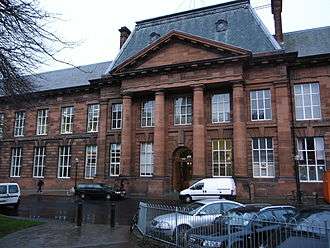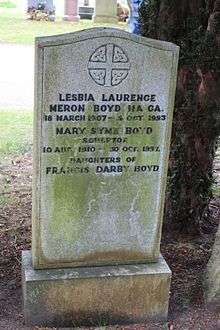Mary Syme Boyd
Mary Syme Boyd (15 August 1910 – 30 October 1997) was a Scottish artist and sculptor who studied at the Edinburgh College of Art from 1929-33. She became known for her animal sculptures and exhibited at the Royal Scottish Academy (RSA) and the Royal Glasgow Institute (RGI).

Mary Syme Boyd | |
|---|---|
| Born | 15 August 1910 Edinburgh |
| Died | 30 October 1997 Edinburgh |
| Resting place | Dean Cemetery, Edinburgh |
| Nationality | Scottish |
| Alma mater | Edinburgh College of Art |
| Known for | Sculptures in plaster, wood, bronze, silver and stone. |
Notable work |
|
Early life and education
Mary Syme Boyd was born in Edinburgh in 1910. Her mother was Clara Constance Lepper (1875-1961) of Co.Antrim. Her father was Francis Darby Boyd (1866-1922),[1] Professor of Clinical Medicine at the University of Edinburgh.
She attended the Edinburgh College of Art from 1929 to 1933. There she had access to a small animal menagerie where students were encouraged to make life studies.[2] Boyd's fascination with animals went on to become the primary subject matter throughout her career.[2]
Like her fellow animal sculptor and Edinburgh College of Art alumni, Phyllis Bone, before her Boyd was awarded a travel scholarship to study in Paris in 1931-32,[1] where she studied under the tutelage of the acclaimed animalier sculptor, Edouard Navellier. There she developed her techniques in bronze casting.
In 1934, Boyd was awarded another scholarship which allowed her to travel to Denmark, Sweden, Germany, Belgium and France. According to the Biographical Dictionary of Scottish Women "her notebooks about her European tour and her wartime service are extraordinary testaments."[1] Whilst travelling, she sought out examples of modern sculpture but also admired pewter, Danish silver and wood carvings in churches.[1] Later that same year, Boyd returned to Edinburgh to settle in Belford Mews, where she stayed until her death.[2]
Apart from the diaries she kept during her European tour and wartime service, little else is known about Boyd's life outside of her artwork other than she did not marry or have children. There are accounts of "her great love of driving and her exploration of the Scottish Highlands" .
She died in Edinburgh on 30 October 1997 and was buried with her sister Lesbia Boyd in Dean Cemetery. The grave lies very close to the main entrance, on the south side of the central east-west path. Her parents lie alongside with a hand-carved stone by Mary. Some records say she carved her own name on her memorial with only the date to infill. Her name is not carved, as her sister's name above it is added in preformed lead letters.
Career
From 1935 to 1963, Boyd's professional career was conducted from a house/studio at 14 Belford Mews.[1] This was only interrupted by her wartime service as part of the London Auxiliary Ambulance Service during the London blitz.[2]
Boyd exhibited at the Royal Scottish Academy (RSA), the Royal Glasgow Institute (RGI), and the Society of Scottish Artists. She worked in plaster, bronze, silver, carved wood, and stone. Her exhibited work consisted of naturalistic animal studies, and allegorical subjects[1] and she undertook a number of ecclesiastical commissions such as work for St. Mary's Episcopal Church in Corstorphine.[2]
Notable works (by year of exhibition)

- Moon - a white cat (1935)
- The wild boar (1935)
- The kestrel (1935)
- Study of a Cat (c.1935)
- Dancers (1936)
- Kestrel carved in Sabique (1936)
- Bird of prey (1945)
- Station of the cross (1951)[3]
Boyd bequeathed Kestrel to the National Galleries of Scotland as representative of her life's work.[2]
"Bird sculptures often took the form of an outstretched-winged hunting bird on a rocky outcrop, usually with a tiny victim writhing in its claws, or in territorial combat with another bird. Boyd's Kestrel, however, eschews these narrative orthodoxies and aligns instead with modernist principles, choosing to depict this bird as a benign creature. Carved from wood, Kestrel's simple lines and unadorned surface serve to illustrate that Boyd was aware of modernist discourse involving 'truth to materials', espoused by Henry Moore and Barbara Hepworth at this time."[2]
Included in the bequest were two additional sculptures: one by Elizabeth Dempster and one by Georg Kolbe.[2]
References
- Ewan, Elizabeth; Innes, Sue; Reynolds, Sian (1 January 2006). The Biographical Dictionary of Scottish Women: From the Earliest Times to 2004. Edinburgh University Press. ISBN 9780748617135.
- Strang, Alice (2015). Modern Scottish Women: Painters and Sculptors 1885-1965. Edinburgh: National Galleries of Scotland. p. 38. ISBN 9781906270896.
- "Miss Mary Syme Boyd - Mapping the Practice and Profession of Sculpture in Britain and Ireland 1851-1951". University of Glasgow. Retrieved 10 March 2016.